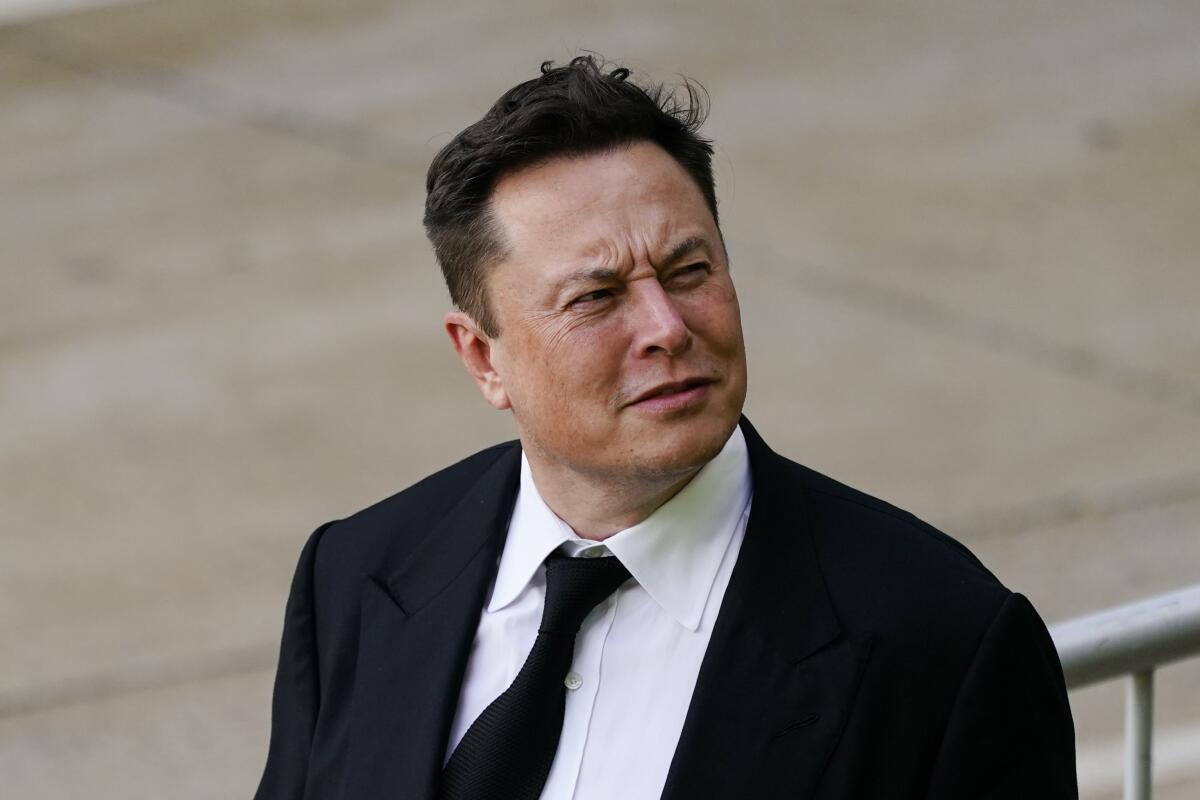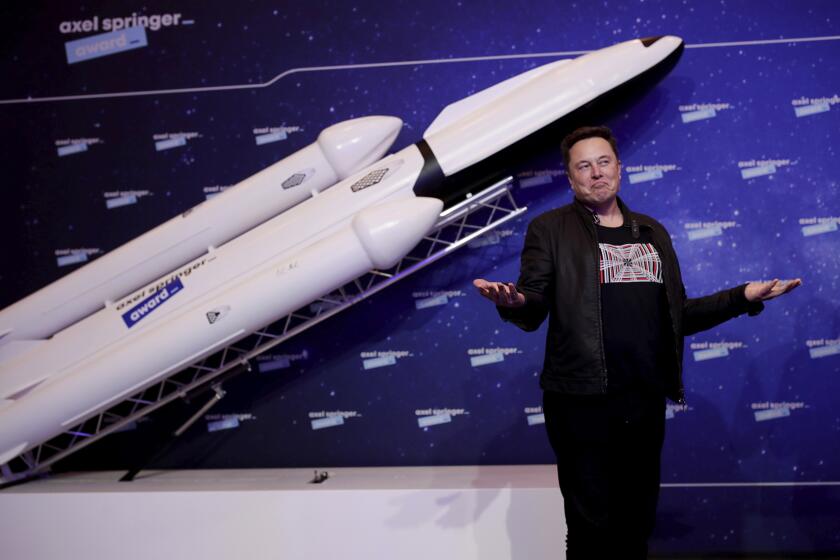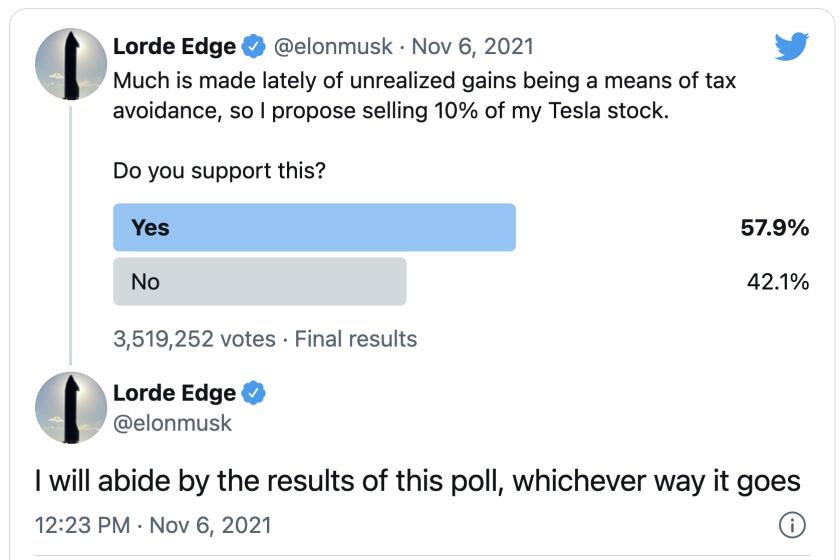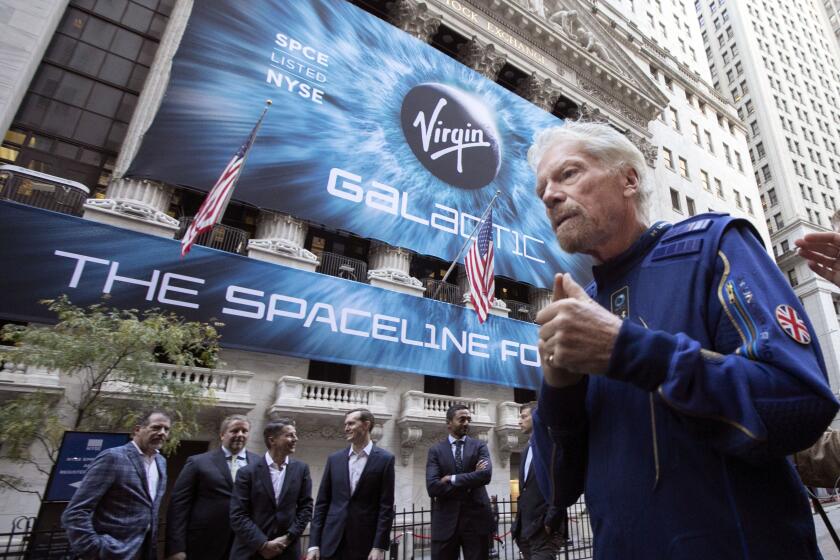Why don’t regulators stop Elon Musk from breaking the law?

- Share via
In his takeover adventure with Twitter, it seems more likely than not that Elon Musk has broken the law.
In some respects, his lawbreaking is easily documented. According to Musk’s own disclosure, his purchases of Twitter shares brought him to 5% ownership of the company stock on March 14.
Securities law requires that any such holding be divulged publicly and to the Securities and Exchange Commission within 10 days, or in this case by March 24; Musk didn’t make the disclosure until April 4, which was 11 days late.
My frank opinion is that the harm from the coronavirus panic far exceeds that of the virus itself.
— Elon Musk in 2020, before U.S. COVID deaths reached 1 million
In financial terms, the consequences weren’t trivial: By our calculations, the delay might have saved Musk more than $170 million in his Twitter purchases. To put it another way, he may have rooked the Twitter stockholders whose shares he bought out of $170 million.
This wouldn’t be the first time Musk has run roughshod over laws or regulations. In the past, he has flouted not only securities rules but other public regulations as well, such as public health rules concerning the pandemic and rules regarding the safe operation of self-driving technologies on public roads.
Get the latest from Michael Hiltzik
Commentary on economics and more from a Pulitzer Prize winner.
You may occasionally receive promotional content from the Los Angeles Times.
Up to now, the general public reaction to this behavior has been limited to a bemused shaking of the head and the thought: “How does he get away with it?” But that’s the wrong framing of the issue. The right framing is: “Why do the authorities let him get away with it?”
Time and time again, Musk has gotten his way with regulators and municipal officials through bluster and intimidation. He’s often backed by fans who make their support known en masse via social media, creating the impression that the voting public generally wants Musk to be left alone.
Authorities seldom use their maximum enforcement powers against Musk. In a case involving a plainly misleading 2018 tweet about his intention to take his Tesla electric vehicle company private at a premium price, the SEC penalized Musk and Tesla $20 million each.
In the context of his personal wealth, which is estimated at about $219 billion based on the value of his Tesla stock, that’s a wrist-slap. The SEC, if it wishes, could move to hit him with a lifetime ban from association with a publicly traded company.
That would be exceptionally harsh — the agency didn’t impose the so-called bad boy penalty in cases involving banks complicit in the 2008 financial crash, and it is seldom even contemplated except when an executive is convicted of a felony. But it’s on the books. In any event, the SEC’s ability to impose much more stringent penalties on Musk than it has thus far is clear.
Musk has been enormously successful at creating the impression that everything he does is for the greater good of humanity, whether it’s building the market for electric vehicles or finding a way to transfer human society to Mars.
Elon Musk has appeared to waste no time before violating his merger agreement with Twitter.
If this were indisputably true, it might warrant giving him a little legal leeway, but by no means the broad indulgence that officials have allowed him.
Among the adversaries that Musk has browbeaten, count the board of Twitter. The board responded to Musk’s disclosure of a 9.2% stake in April by reaching an agreement for him to take a board seat. He then refused the board seat and issued an offer to take over the company for $54.20 a share. The board quickly agreed.
But now Musk is acting as though he wants to bail out on the deal, leaving the Twitter board with few options: They could accept the $1-billion breakup fee written into the takeover contract, or try to force him to complete the deal on the agreed-upon terms.
Neither option would make the board look smart or even professional. That’s part of Musk’s secret — he gives his adversaries the impression that they have no choice but to give him what he wants.
Musk isn’t the first entrepreneur, high-tech or otherwise, to act as though traditional rules and regulations don’t apply to him.
Uber co-founder and former Chief Executive Travis Kalanick polished the technique to a high luster: When local officials tried to regulate or block his ride-hailing company’s entry into their markets, he browbeat them with the accusation that they were standing in the way of a revolution that would bring cheap and reliable transportation to the people.
Often, the regulators backed down. In California, the Public Utilities Commission carved out a regulatory exception for Uber and Lyft, blocking local initiatives aimed at equalizing ride-hailing regulations with those of taxis, the drivers of which were generally subject to more stringent background checks and vehicle inspections than ride-hailing drivers.
The idea that the PUC could step in and oversee the companies’ activities was nothing but a mirage. As former PUC President Michael Picker eventually acknowledged, ride-hail regulation was not “something we can do effectively.”
Elon Musk has used Twitter to violate securities law and smear his critics. Placing him on the Twitter board is a terrible idea.
As for the ostensibly indisputable benefits and virtues of the ride-hailing revolution, they’re also highly illusory. Studies have found that when Uber and Lyft enter a market, their fleets are more polluting than autos on average; contribute to more traffic congestion, particularly in the central cities; undermine public transit systems; and devastate the local taxi industry.
Authorities who capitulated to Kalanick’s bluster may have figured that if they yielded a bit on Uber’s demands, the company and its fellows in the gig economy would become model citizens. That approach never works. Instead, years of indulgent treatment (along with tens of billions of capital from venture investors) provided the companies with enough money to rewrite California labor law in their own interest.
Musk adheres to the tradition of taking legal and regulatory forbearance as an inducement and invitation to demand more. The Economist described his viewpoint succinctly: “He paints stewards of fair play — regulators and boards — as pettifogging enemies of progress,” wrote its pseudonymous business columnist “Schumpeter.”
The evidence suggests that regulators have leaned over backward to satisfy Musk. The California Department of Motor Vehicles, for example, has consistently failed to hold Musk’s electric vehicle company to the same standards for autonomous driving technology as it does other robot car developers.
Among other breaks given Tesla, as my colleague Russ Mitchell has documented, the company hasn’t been required to report crashes and system failures associated with the Full Self-Driving iteration of its Autopilot feature to the DMV. Unlike competitors such as Waymo, Cruise, Argo and Zoox, Tesla allows its program to be tested on public roads by untrained drivers.
Elon Musk thinks tax policy is a game. He should be made to pay.
The harvest has been a flood of YouTube and Twitter posts showing Teslas driving into oncoming traffic, mistaking railroad tracks for paved streets and aiming themselves into metal posts and traffic barriers.
Tesla even briefly added a “rolling stop” feature that allowed cars equipped with the program to roll past stop signs without coming to a full stop, a dangerous practice that is illegal in almost every state. The company removed the feature after an uproar ensued.
In January, the California DMV said it would reassess its tolerant treatment of Tesla’s self-driving testing. This is the opposite of the proactive approach that motorists should expect its regulators to take toward technical innovations that present manifest hazards to the public.
It is, however, similar to the approach of federal regulators such as the National Transportation Safety Board, which has been similarly lenient. NTSB Chair Jennifer Homendy, a Biden appointee, last October publicly questioned why Tesla had been allowed to ignore the board’s 2017 safety recommendation for driver-assistance programs for years.
The board had made the recommendation to Tesla and five other companies with such programs, Homendy said in a letter addressed to Musk. “Tesla is the only manufacturer that did not officially respond to us about the recommendation,” she wrote.
Meanwhile, the National Highway Traffic Safety Administration has 14 deaths potentially associated with Tesla programs under investigation. These actions, also, are reactive rather than proactive. How many deaths must be investigated before the regulator stops allowing Tesla’s program to be deployed in public?
During the pandemic, Musk took the attitude that the danger of COVID-19 had been exaggerated and that public health measures that affected his company were unwarranted. In March 2020, Tesla’s Fremont, Calif., factory continued operating despite an order from Alameda County authorities that it be shut down in compliance with anti-pandemic policies.
Hiltzik: The Bezos-Branson-Musk space race is a huge waste of money and scientifically useless
An effort to be the first billionaire in space is the biggest vanity project in history.
“My frank opinion is that the harm from the coronavirus panic far exceeds that of the virus itself,” Musk wrote in a message to employees. He predicted that COVID-19 cases “will not exceed 0.1% of the population.” In the U.S., cases have reached about 25% of the population, and deaths alone have reached 0.3%.
Alameda authorities soon backed down, allowing the Fremont plant to continue operating. The plant emerged as a local hotspot for COVID infections, with more than 400 cases recorded between May and December 2020 among its 10,000 workers.
Then there’s the relationship between the SEC and Musk. The agency took action against Musk in 2018 over his tweet declaring that he was intending to take Tesla private for $420 per share, a substantial premium over its price at the time. The tweet said funding for the transaction was “secured.”
In fact, there was no funding, and Musk had taken no significant steps toward any such deal. His tweet set off a brief trading frenzy in Tesla stock.
The agency and Musk eventually settled the agency’s lawsuit over the tweet with a deal requiring Musk and Tesla each to pay a penalty of $20 million, and for Musk to step down from his position as Tesla chairman. He was permitted to remain as CEO.
His future tweets about Tesla were to be reviewed by company lawyers before they could be posted, the settlement mandated. Musk did not deny the agency’s allegations that he had violated securities laws.
Yet Musk continued to issue tweets that appeared to violate the deal, prompting the agency to return to court to make its terms crystal clear. The SEC may have thought that would settle the matter, but it didn’t. Last November, Musk tweeted about possibly selling a sizable portion of his Tesla shares, without clearing the tweets in advance.
The SEC subpoenaed records related to the tweets, prompting Musk to ask a judge to invalidate the original deal on the claim that he had been coerced into signing it. The judge refused.
Musk’s purported deal to buy Twitter and take the company private is chock full of the same in-and-out running. When he finally disclosed his share buying on April 4, he did so on a form reserved for passive investors, those with no intention of controlling the target company.
At the time, however, according to a disclosure filed by Twitter on Tuesday, he already had told Twitter’s chairman and CEO “that he was considering various options with respect to his ownership, including potentially joining the Twitter board, seeking to take Twitter private or starting a competitor to Twitter.”
More recently, Musk has been signaling that he may not want to acquire Twitter after all, raising a manifestly thin excuse for putting the transaction “on hold.” Whichever way you cut, at least some of Musk’s comments have been fundamentally misleading.
These are by no means victimless offenses. Tesla shares soared by about 6% shortly after his taking-private tweet, which meant that at least some buyers were fooled into overpaying. Then there’s Musk’s delayed disclosure of his Twitter share purchases. In the trades between the date Musk was required to disclose his purchases and the day he finally did so, he acquired 13.1 million shares for about $513.2 million, or an average of about $39.05 each. Twitter closed at $38.29 Friday.
On April 5, the day after he disclosed, Twitter shares rose to about $51, based at least partially on investor enthusiasm about his interest in the company. Had he made a timely disclosure and shares hit that level on March 25, he would have spent about $670.2 million for the same shares, or about $157 million more.
Obviously, it’s impossible to do more than conjecture about what Twitter’s price would be between March 25 and April 4 if Musk disclosed as required, but it’s reasonable to say that he saved a bundle by delaying his disclosure, and Twitter shareholders, for whom his buying plainly was of material interest, made that much less.
Musk’s maneuvering over Twitter could be the high-water mark of his manipulative method. If the deal falls through, it could be harder for any potential partner to take him at his word. But more important is the corrosive effect Musk’s actions have had on the rule of law and principles of fair dealing.
If he’s allowed to skate on his evident violations of securities law and reckless treatment of the market, then more billionaires who care only about their own level of self-esteem will feel even freer to take advantage of the rest of us.
More to Read
Get the latest from Michael Hiltzik
Commentary on economics and more from a Pulitzer Prize winner.
You may occasionally receive promotional content from the Los Angeles Times.















